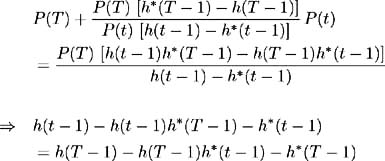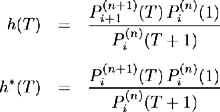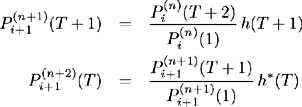10.3 Arbitrage-free interest rate evolution
10.3 Arbitrage-free interest rate evolution
The movement of the term structure must be constrained to ensure that no arbitrage principles are not violated. This translates to constraints on the binomial lattice modelling the term structure evolution. HL impose an additional restriction which simplifies the construction of the pricing lattice. The perturbation functions and implied binomial probability ( h ( T ), h *( T ) and respectively [1] ) are taken to be independent of time n and state i . This is equivalent to the continuous time constant volatility assumption. Allowing this functional dependence would lead to a more general arbitrage-free model.
10.3.1 The perturbation functions.
Consider the time n , state i discount function P ( n ) i ( T ). If there is no interest rate risk/uncertainty over the next time period, then the time ( n +1) discount functions and hence entire term structure must be the same in the upstate and downstate. To prevent arbitrage opportunities, the realised (time ( n + 1)) discount function must be the (time n ) implied forward discount function, F ( n ) i ( T ):
In this riskless world, if the realised discount function differs from the implied forward discount function, arbitrage opportunities exist. Hence, modelling term structure uncertainty reduces to determining the perturbation of the next period discount function from the implied forward discount function.
Let h ( T ) and h *( T ) be two perturbation functions where:
define the upstate and downstate perturbations respectively. These two perturbations specify the deviation, from the implied forward discount function, of the upstate and downstate discount functions. Hence these functions give an indication of the difference between the upstate and downstate discount functions in the next period. For h ( T ) >> 1( h *( T ) << 1) for all bond maturities, the bond prices will consistently rise in the upstate (fall in the downstate).
Conditions (10.1) to (10.3) imply that:
and [2]
The magnitude of the perturbation depends on bond maturity and hence h ( ·) and h *( ·) are functions of T . To construct the binomial lattice determining the term structure movement, we require the set of perturbation functions { h ( T ), h *( T ): ˆ T } and the initial discount function P (0) ( T ) = P ( T ).
10.3.2 The implied binomial probability.
As stated above, knowing the perturbation functions and initial discount function, allows us to construct the term structure movement. However, the modelled evolution of various maturity interest rates relative to each other must be such that profitable arbitrage opportunities do not arise. Hence consider a portfolio of two different maturity discount bonds held in proportions such that risk-free rate of return is realised over the next time period. To preclude profitable arbitrage, this risk-free rate of return must equal the return on a one period discount bond. This requirement implies a restriction on the perturbation functions at each node ( n, i ) of the lattice. These restrictions can be determined by constructing the above mentioned risk-free portfolio:
At any time n , state i we construct a portfolio with:
-
1 discount bond with maturity T ,
-
¾ discount bonds with maturity t .
Suppressing the notational dependence on time and state ( n, i ), the value of the portfolio is:
Depending on whether an upstate or downstate move occurs during the next time period, use (10.5) or (10.6) to revalue the portfolio:
For a risk-free portfolio, we require V (upstate) = V (downstate), so:

To prevent profitable arbitrage, a risk-free portfolio must yield, after one period, the return on a one period discount bond, i.e. 1/ P (1). Therefore, we require [3] :

Substituting the calculated value of ¾ from (10.9) we have

Substituting (10.9) and (10.11) into (10.10):

Adding h *( T ˆ’ 1) h *( t ˆ’ 1) to both sides and factorising:

The LHS of (10.12) is a function of T only, while the RHS is a function of t only. This can only hold true if
where is some constant. More generally , we write:
and so
If the condition in (10.13) is satisfied across all bond maturities, profitable arbitrage opportunities are precluded.
The constant is independent of bond maturity T and the initial discount function P ( T ), but it may depend on time n and state i . We refer to as the implied binomial probability.
10.3.3 Comparison to traditional option pricing approach.
Consider solving (10.5) and (10.6) for h ( T ) and h *( T ) respectively:

Substituting the above values into (10.13), we have:

which is consistent with the traditional binomial tree approach to option pricing introduced by Cox, Ross and Rubinstein [ 19 ]. In their approach the price at time n is the weighted sum of prices at time ( n + 1), discounted by the risk-free rate over this one time period. The appropriate weights are the probabilities of the time ( n + 1) prices being attained. For this reason may be viewed as a risk-neutral probability.
Let us examine (10.14) in more detail. Rearranging terms, we have:

where

and
Hence

and may be interpreted as the extent of the downstate move with respect to the spread between an upstate and downstate move. Large implies a general price decrease over the next time period, while for values of close to zero, a general price rise may be expected over the next time period. The required no arbitrage condition of equation (10.12) implies that this ratio (i.e. the general increase/decrease in the bond price over the next time period) must be the same for all bond maturities [4] T .
Cox, Ross and Rubinstein applied a constant discount rate at all points of the binomial tree. In this model the one-period discount rate is time and state dependent. This is due to the one-period rates, P ( n ) i (1) for all n, i being determined by the initial term structure and hence endogenised by the no arbitrage methodology.
10.3.4 Constraints to ensure path independence.
As we construct the binomial tree/lattice, the discount function evolves according to the number of upstate and downstate moves only, not their sequence. This condition implies constraints on h *, h , and so that at any time n , state i , an upward move, followed by a downward move is equivalent to a downward move followed by an upward move. We examine the restrictions required to ensure this path independence.
First, consider a downward move, followed by an upward move to get from P ( n ) i ( T + 2) to P ( n +2) i +1 ( T ). From (10.6) the downward move is represented by:
and then from (10.5) the upward move is:
Hence we have:
Also, we may write:

Similarly, an upward move, followed by a downward move yields:

and

The path independence condition means that (10.15) must equal (10.16) so:

From (10.13) we may express h *( ·) as a function of h ( ·):
so (10.17) simplifies as:

Letting
we may represent the condition guaranteeing path independence as a first- order linear difference equation of the form:
10.3.5 Solution to the first-order linear difference equation.
Let ![]() and so
and so ![]() and (10.19) may be written as:
and (10.19) may be written as:
First, let x r +1 = E ( x r ) = x r + ” x and consider the solution to the homogeneous part of the difference equation:
which has the root and the solution [5] is g H r = k 1 r , where k 1 is a constant.
Now calculate the particular part of the solution:

This equation has roots and 1, so the particular solution [6] is g P r = k 2 r + k 3 where k 2 and k 3 are again constants. Since r is included in the homogeneous part of the solution, we exclude it and substitute g P r = k 3 into (10.20) to solve for the constant. Hence [7] :

So the solution to (10.19) is

The initial condition on h requires h (0) = 1, so from (10.21) k 1 =1 ˆ’ and the unique solution is determined as:
Equation (10.13) gives the relationship between h ( T ) and h *( T ) required to preclude profitable arbitrage. It may be used in conjunction with (10.22) to solve for an h *( T ) which maintains the no arbitrage equilibrium. Substituting (10.22) into (10.13) to have:

For a given pair of constraints, and (which corresponds to a specification of h (1)), the unique arbitrage-free model is fully specified by (10.5), (10.6), (10.22) and (10.23). Here is the implied binomial probability and determines the spread between the perturbation functions h ( ·) and h *( ·).
[1] These variable names are given here for completeness only; the investigation which follows defines these variables correctly in the appropriate context.
[2] Consider (10.5) and (10.6) with T = 0

since all bonds mature with face value 1.
[3] By the choice of ¾ as the value resulting in equal portfolio values in the upstate and downstate, we may also use the portfolio value after an upstate move to give
in place of (10.10).
[4] This is the discrete time equivalent of the continuous time condition that to preclude arbitrage opportunities the instantaneous return on bonds of all maturities must be the same.
[5] Here the superscript H denotes the homogeneous part of the solution.
[6] Here the superscript P denotes the particular part of the solution.
[7] Making use of the definitions of ³ and in (10.18) we calculate ³ /(1 ˆ’ ) =
EAN: 2147483647
Pages: 132